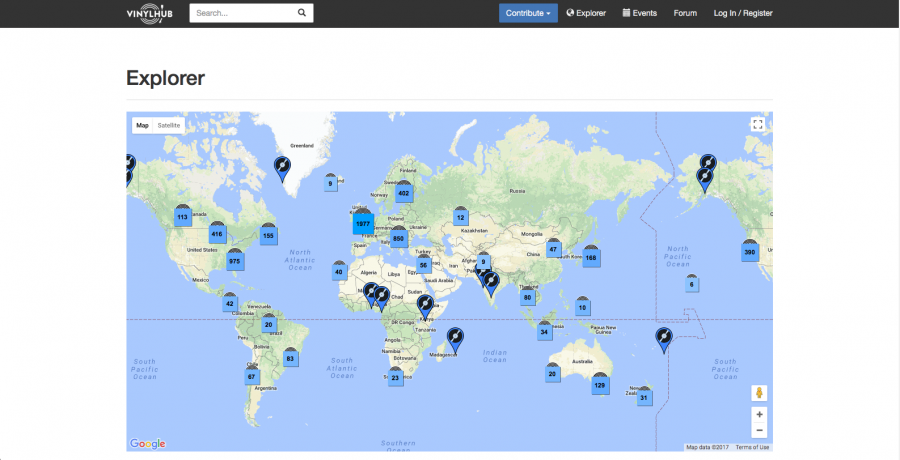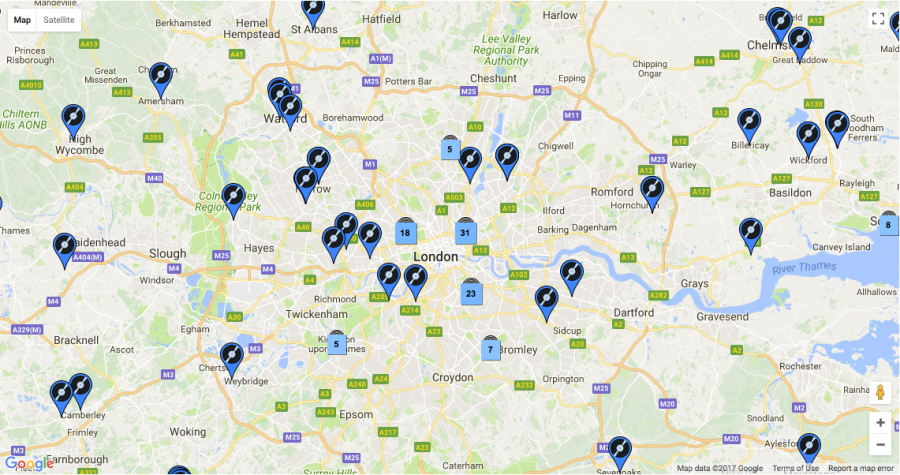[Most Recent Entries] [Calendar View]
Thursday, November 16th, 2017
| Time | Event |
| 9:00a | Beautiful & Outlandish Color Illustrations Let Europeans See Exotic Fish for the First Time (1754)
Whether in the tanks into which we gaze at the aquarium or the CGI-intensive wildlife-based gagfests at which we gaze in the theater, most of us in the 21st century have seen more than a few funny fish. Eighteenth-century Europeans couldn't have said the same. The great majority passed their entire lives without so much as a glance at the form of even one live exotic creature of the deep, and most of those who have a sense of what such a sight looked like probably got it from an illustration. But even so, some of the illustrated fish of the day must have proven unforgettable, especially the ones in Louis Renard's Poissons, Ecrevisses et Crabes.
First published in 1719 with a second edition, seen here, in 1754, Renard's book, whose full title translates to Fishes, Crayfishes, and Crabs, of Diverse Colors and Extraordinary Form, that Are Found Around the Islands of the Moluccas and on the Coasts of the Southern Lands, showed its readers, in full color for the very first time, creatures the likes of which they'd never have had occasion even to imagine. The book's 460 hand-colored copper engravings depict, according to the Glasgow University Library, "415 fishes, 41 crustaceans, two stick insects, a dugong and a mermaid."
The specimens in the first part of the book tend toward the realistic, while those of the second "verge on the surreal," many of which "bear no similarity to any living creatures," some of which bear "small human faces, suns, moons and stars" on their flanks and carapaces, most possessed of colors "applied in a rather arbitrary fashion," though brilliantly so. In the short accompanying texts, "several of the fish" — presumably not the mermaid — "are assessed in terms of their edibility and are accompanied by brief recipes."
Renard himself, who lived from 1678 to 1746, seems to have had a career as colorful as the fish in his book. "As well as spending some seventeen years as a publisher and bookdealer," he also "sold medicines, brokered English bonds and, more intriguingly, acted as a spy for the British Crown, being employed by Queen Anne, George I and George II." Far from keeping that part of his life a secret, "Renard used his status as an 'agent' to help advertise his books. This particular work is actually dedicated to George I while the title-page describes the publisher as 'Louis Renard, Agent de Sa Majesté Britannique.'"
You can behold more of Poissons, Ecrevisses et Crabes at the Public Domain Review. "If the illustrations are breathtaking to us now, with all the hours of David Attenborough documentaries under our belts," they write, "one can only imagine the impact this would have had on a European audience of the eighteenth century, to which the exotic ocean life of the East would have been virtually unknown."
Though received as a respectable scientific work in its day — and even, as the Glasgow University Library puts it, "a product of the Enlightenment" — the book now stands as an enchanting tribute to the combination of a little knowledge and a lot of human imagination.
Related Content: 1,000-Year-Old Illustrated Guide to the Medicinal Use of Plants Now Digitized & Put Online Wonderfully Weird & Ingenious Medieval Books Based in Seoul, Colin Marshall writes and broadcasts on cities and culture. His projects include the book The Stateless City: a Walk through 21st-Century Los Angeles and the video series The City in Cinema. Follow him on Twitter at @colinmarshall or on Facebook. Beautiful & Outlandish Color Illustrations Let Europeans See Exotic Fish for the First Time (1754) is a post from: Open Culture. Follow us on Facebook, Twitter, and Google Plus, or get our Daily Email. And don't miss our big collections of Free Online Courses, Free Online Movies, Free eBooks, Free Audio Books, Free Foreign Language Lessons, and MOOCs. |
| 12:00p | An Interactive Map of Every Record Shop in the World
Arriving in a new city usually means finding the nearest decent grocery, pharmacy, coffee shop, bookstore, laundry, etc. And before nearly every musical whim could be satisfied with a few clicks, it also meant for many people finding the nearest record store. Even the local strip mall chain might hold a surprise or two. But the true finds appeared among the small proprietors, merchandisers of dusty LPs in wooden bins and keepers of local music scene lore. Entering a well-curated music shop can feel like walking into a medieval apothecary. Whatever ails you, you’re sure to find a remedy here. If it doesn’t work, there remains a certain magic in the transaction. We continue to believe in music even when it lets us down.
But have we lost faith in the record shop? I hope not. Online streaming and buying has the regrettable effect of flattening everything into the same two dimensions without the aura of physical media and the musical paraphernalia we find in real life stores. Should you be among the unlucky who lack a local music store, fear not. You can recover the romance by traveling to any one of the thousands of shops worldwide that are catalogued and mapped on VinylHub, a crowd-sourced “endeavor,” Ron Kretsch writes at Dangerous Minds, "to create an interactive map of every brick-and-mortar record store on Earth, a perfect resource for the world-traveling vinyl obsessive.”
Brought to us by masterminds behind Discogs and their similar spin-off online catalogs for books, movies, etc., this project might get us out of our chairs—maybe even out the country—and into new places to dig through the crates. But even if we’re not inclined to leave the house, VinylHub offers a wealth of fascinating information. “The single city with the largest density of shops,” we learn, “is Tokyo,” though “had you asked me,” Kretsch writes, “I’d have probably said London.” I’d have guessed New York, which comes in at a surprising 7th pace.
The UK is currently second in number of shops by country: 537, with .8443 shops per 100,000 inhabitants. The United States at number one has almost triple that number, but also over five times the population. These figures are provisional. Much of the world remains uncharted—at least as far as record shops are concerned—and Discogs members continue to submit new entries. Should you find a blank spot on the map that needs a little record icon, you can join for free and contribute to the VinylHub community. While there’s nothing like a trip to a new music store, even if you’re only in it for the data, you’ll find much here to inspire.
Over at the Discogs blog, we learn several more facts, such as the two shops that are farthest apart (Madrid’s Citadel Records and Star Second-Hand Book-Music in Palmerston North, New Zealand: 19,978 km) and the location of that most remote shop (the market in Nuku’alofa in Tonga, address: “Upstairs of wet market”). VinylHub’s “Explorer” map utilizes Google Maps features to give you unlimited access to every region in the world. Zoom in to see the numbers by city and the individual locations of each and every shop in the database. You can even find record stores listed in Pyongyang—or rather record sections of several hotel bookshops. I wouldn't necessarily recommend making the trip, but it’s interesting to imagine what odd treasures we might find there—or at any of the other several thousand shops from around the world.
Related Content: You Can Have Your Ashes Turned Into a Playable Vinyl Record, When Your Day Comes How Vinyl Records Are Made: A Primer from 1956 Josh Jones is a writer and musician based in Durham, NC. Follow him at @jdmagness An Interactive Map of Every Record Shop in the World is a post from: Open Culture. Follow us on Facebook, Twitter, and Google Plus, or get our Daily Email. And don't miss our big collections of Free Online Courses, Free Online Movies, Free eBooks, Free Audio Books, Free Foreign Language Lessons, and MOOCs. |
| 3:00p | Herbie Hancock Now Teaching His First Online Course on Jazz A quick update to something we first mentioned last June. On Masterclass, jazz legend Herbie Hancock is now teaching his first online course on jazz. In 25 video lessons, the 14-time Grammy winner shares his approach to improvisation, composition, and harmony, and gives students access to 10+ original piano transcriptions, including 5 exclusive solo performances. Plus there's a downloadable workbook. The cost is $90. You can enroll yourself, or give the course as a gift. Check it out here. Follow Open Culture on Facebook and Twitter and share intelligent media with your friends. Or better yet, sign up for our daily email and get a daily dose of Open Culture in your inbox. If you'd like to support Open Culture and our mission, please consider making a donation to our site. It's hard to rely 100% on ads, and your contributions will help us provide the best free cultural and educational materials. Note: MasterClasss and Open Culture have a partnership. If you sign up for a MasterClass course, it benefits not just you and MasterClass. It benefits Open Culture too. So consider it win-win-win. Related Content: Watch Herbie Hancock Rock Out on an Early Synthesizer on Sesame Street (1983) Herbie Hancock Presents the Prestigious Norton Lectures at Harvard University: Watch Online Herbie Hancock Now Teaching His First Online Course on Jazz is a post from: Open Culture. Follow us on Facebook, Twitter, and Google Plus, or get our Daily Email. And don't miss our big collections of Free Online Courses, Free Online Movies, Free eBooks, Free Audio Books, Free Foreign Language Lessons, and MOOCs. |
| 5:40p | Watch Classical Music Come to Life in Artfully Animated Scores: Stravinsky, Debussy, Bach, Beethoven, Mozart & More Stephen Malinowski has cultivated his own patch of YouTube ground over the years with the Music Animation Machine, slowly scrolling visual representations of classical music. The videos, like the one above, use shape and color to interpret pitch, duration, and more recently dynamics and intervals in a hypnotic style that references both Oskar Fischinger and Guitar Hero. Personally, I’ve been a fan for years and watched his style evolve from the basics of a “piano roll” scroll to these much more complex animations, just as smalin (his YouTube name) has gone from working with solo piano works to the density of Beethoven’s symphony scores or the chaos of Stravinsky’s Rite of Spring. Many music lovers who are not musicians but understand enough about composition will often follow a printed score when listening to classical music; I would suggest that this is one better than the traditional notation, as smalin’s method makes individual instruments in a quartet easy to follow; or show the interplay between left and right hands in a Debussy piece; or lay out in visual terms the variations on a theme or pattern (especially in Bach). For those who love but “don’t get” classical music, these videos are a step towards clarity. The Music Animation Machine started long before the Internet. Malinowski (a graduate of my alma maters SBCC and UCSB!) dates the beginning to 1982, and the inspiration came from a "hallucination" he had while listening to Bach's Sonatas and Partitas for Unaccompanied Violin.
The idea to animate was suggested by a friend and dovetailed into the technology of the time, especially the birth of MIDI. Too self-critical to be a performer and too forgetful to be a composer, Malinowski turned to computer programming and visualizing scores as the listener, not the performer, understands them. It’s been his life’s work. Explore his big collection of animations and also his animation techniques. Be wary, though. Watching one isn’t enough--writing this article was a continual struggle between the deadline and animated bliss. You just may find yourself similarly and pleasantly lost. Note: Here's a list of Malinowski favorite and most popular videos: Grainger, Children's March Related Posts: Optical Poems by Oskar Fischinger, the Avant-Garde Animator Hated by Hitler, Dissed by Disney Discover the 1950s & 1960s Computer & Cut-Up Animation of Pioneering Filmmaker Stan VanDerBeek The Genius of J.S. Bach’s “Crab Canon” Visualized on a Möbius Strip Ted Mills is a freelance writer on the arts who currently hosts the artist interview-based FunkZone Podcast and is the producer of KCRW's Curious Coast. You can also follow him on Twitter at @tedmills, read his other arts writing at tedmills.com and/or watch his films here. Watch Classical Music Come to Life in Artfully Animated Scores: Stravinsky, Debussy, Bach, Beethoven, Mozart & More is a post from: Open Culture. Follow us on Facebook, Twitter, and Google Plus, or get our Daily Email. And don't miss our big collections of Free Online Courses, Free Online Movies, Free eBooks, Free Audio Books, Free Foreign Language Lessons, and MOOCs. |
| << Previous Day |
2017/11/16 [Calendar] |
Next Day >> |
















